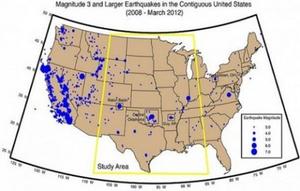EarthquakesOklahoma worries that fracking-induced earthquakes threaten the state’s bridges
Many residents in Oklahoma are questioning whether hydraulic fracking is to blame for the sudden increase in earthquakes, but for transportation officials, the security of the state’s 6,800 bridges is the immediate concern. There are 468 bridges in Oklahoma which are classified as “structurally deficient,” and most were not built with frequent earthquakes in mind. Earthquakes have become so common, however, that inspectors have had to inspect bridges several times a week.

Note the concentration of earthquakes in Oklahoma // Source: usgs.gov
Many residents in Oklahoma are questioning whether hydraulic fracking is to blame for the sudden increase in earthquakes, but for transportation officials, the security of the state’s 6,800 bridges is the immediate concern. There are 468 bridges in Oklahoma which are classified as “structurally deficient,” and most were not built with frequent earthquakes in mind. Earthquakes have become so common, however, that inspectors have had to inspect bridges several times a week.
Officials from the Oklahoma Department of Transportation (ODOT) have decided that it would be prudent to seek assistance on the issue of bridges and earthquake from the California Department of Transportation (Caltrans).
Government Technology quotes Paul Green, ODOT’s director of operations, to say that the department is using a visit from California officials to develop an interim policy. ODOT plans to implement several checklists that Caltrans uses in assessing bridges after earthquakes. Caltrans officials discussed which bridge designs were most vulnerable to earthquake damage, focusing on bridges which are narrow, have unstable bearings, or those that have supports that are not perpendicular to the ground.
Caltrans uses a computer program called QuakeCast which alerts inspectors minutes after an earthquake to which bridges are most likely to be damaged. Green notes that although Oklahoma has made strides in fixing up worn-out bridges, the state will have roughly 1,200 spans that are more than 80 years old by 2021. “Those bridges were designed in the Model A era,” he says. “They certainly weren’t designed for today’s traffic loads. So anything that puts additional stress on those bridges is worrisome.”
The Oklahoma Geological Survey recently said that little evidence links the increase in earthquakes to the expansion of hydraulic fracking, and the group noted that some of the techniques used in fracking had already been used in Oklahoma for years without causing earthquakes. Just five years ago, however, residents could anticipate one to three earthquakes a year, but since 2009, the state has had roughly forty earthquakes per year.
The U.S. Geological Survey has concluded that the rapid increase in the number of earthquakes does “not seem to be due to typical, random fluctuations in natural seismicity rates.” The group is studying whether fracking is to blame for the surge in earthquakes. Geologists in Kansas and Ohio are investigating similar claims.
Paolo Gardoni, director of the MAE Center at the University of Illinois at Urbana-Champaign, which studies how to minimize damage from natural and man-made disasters, says that the new focus on the dangers of earthquakes will force Oklahoma officials to evaluate whether they need to strengthen their bridge design code or fix structures. Much of California’s earthquake mitigation came after the 1994 Northridge earthquake, despite prior knowledge of earthquake risks. “Until something happens, until there is some damage, until maybe somebody dies, too many things don’t get done,” Gardoni says. “Now, after a few earthquakes occurred (in Oklahoma), it may be the time to reassess and think a little bit ahead of time.”
